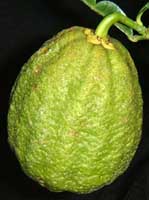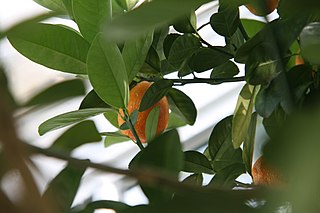
Kumquats, or cumquats in Australian English, are a group of small, angiosperm, fruit-bearing trees in the family Rutaceae. Their taxonomy is disputed. They were previously classified as forming the now-historical genus Fortunella or placed within Citrus, sensu lato. Different classifications have alternatively assigned them to anywhere from a single species, Citrus japonica, to numerous species representing each cultivar. Recent genomic analysis defines three pure species, Citrus hindsii, C. margarita and C. crassifolia, with C. × japonica being a hybrid of the last two.

Citrus is a genus of flowering trees and shrubs in the rue family, Rutaceae. Plants in the genus produce citrus fruits, including crops such as oranges, lemons, grapefruits, pomelos, and limes. The genus Citrus is native to South Asia, East Asia, Southeast Asia, Melanesia, and Australia. Various citrus species have been used and domesticated by indigenous cultures in these areas since ancient times. From there its cultivation spread into Micronesia and Polynesia by the Austronesian expansion ; and to the Middle East and the Mediterranean via the incense trade route, and onwards to Europe and the Americas.

Calamansi, also known as calamondin, Philippine lime, or Philippine lemon, is a citrus hybrid cultivated predominantly in the Philippines. It is native to the Philippines, parts of Indonesia, Malaysia, and Brunei, as well as parts of southern China and Taiwan.

Citrus myrtifolia (chinotto), the myrtle-leaved orange tree, is a species of Citrus with foliage similar to that of the common myrtle. It is a compact tree with small leaves and no thorns which grows to a height of three metres (10 ft) and can be found in Malta, Libya, the south of France, and Italy (primarily in Liguria, typically Savona, and also in Tuscany, Sicily, and Calabria).

The tangelo, Citrus × tangelo, is a citrus fruit hybrid of a Citrus reticulata variety, such as mandarin orange or tangerine, and a Citrus maxima variety, such as a pomelo or grapefruit. The name is a portmanteau of 'tangerine' and 'pomelo'.

Sudachi is a small, round, green citrus fruit of Japanese origin that is a specialty of Tokushima Prefecture in Japan. It is a sour citrus, not eaten as fruit, but used as food flavoring in place of lemon or lime. Genetic analysis shows it to be the product of a cross between a yuzu and another citrus akin to the koji and tachibana orange.

An oroblanco, oro blanco, or sweetie(Israel) is a sweet seedless citrus hybrid fruit similar to grapefruit. It is often referred to as oroblanco grapefruit.

Sweet lemon and sweet lime refer to groups of citrus hybrids that contain low acid pulp and juice. They are hybrids often similar to non-sweet lemons or limes, but with less citron parentage. Sweet limes and lemons are not sharply separated:
The sweet lime, Citrus limettioides Tan., is often confused with the sweet lemon, C. limetta Tan., which, in certain areas, is referred to as "sweet lime". In some of the literature, it is impossible to tell which fruit is under discussion.

Papeda or papaeda is the common name for a group of Citrus species and varieties native to tropical Asia that are hardy and slow-growing, and produce unpalatable fruit. Walter Tennyson Swingle segregated these species into a separate subgenus, Papeda, that included the Ichang lemon, yuzu, kaffir lime, kabosu, sudachi, and a number of wild and uncultivated species and hybrids. Recent genetic analysis shows the papedas to be distributed among distinct branches of the Citrus phylogenetic tree, and hence Swingle's proposed subgenus is polyphyletic and not a valid taxonomic grouping, but the term persists as a common name.

The UCR Citrus Variety Collection (CVC) is one of the most important collections of citrus diversity in the world. It is used for research, plant breeding, and educational extension activities on the UC Riverside campus in Riverside, California.

Citrus macroptera, natively known as hatkhora or cabuyao, Melanesian papeda, or wild orange, is a semi-wild species of citrus native to the Sylhet region of Bangladesh and the Barak Valley Division of the Indian state of Assam.

The kishu mikan is a hybrid variety of mikan, or mandarin orange, found in Southern China and also grown in Japan.
Chōzaburō Tanaka, often Romanized as Tyôzaburô Tanaka, was a Japanese botanist and mycologist. He established one of the two major taxonomic classification systems for citrus and related genera currently in use, and is now considered to be a taxonomic "splitter". He is the author of 180 botanical names in the citrus family Rutaceae, including for example Citrus × latifolia and Citrus tangerina (tangerine). Many of the species Tanaka described are still recognized, but his overall scheme is not supported by modern genetic research.

Hyuganatsu is a citrus fruit and plant grown in Japan. The name comes from Hyūga, the ancient name of Miyazaki Prefecture in Kyushu, where the citrus is said to have originated, while "natsu" (夏) means summer. Hyūganatsu grown outside Kyushu are sometimes shipped under different names such as Konatsu (小夏), Tosakonatsu (土佐小夏), or New Summer Orange (ニューサマーオレンジ).
Ikuro Takahashi was a Japanese botanist, specializing in citrus, who was hailed as the "father of citrus" especially in his native Shizuoka Prefecture.

Citrus taxonomy refers to the botanical classification of the species, varieties, cultivars, and graft hybrids within the genus Citrus and related genera, found in cultivation and in the wild.
Citrus rootstock are plants used as rootstock for citrus plants. A rootstock plant must be compatible for scion grafting, and resistant to common threats, such as drought, frost, and common citrus diseases.
Citrus platymamma, called byeonggyul in Korean and benjul in Jeju, is a Korean citrus fruit native to Jeju Island.

Koji orange, also called smooth-fruited orange in English, bingyul in Korean, 光橘, 柑 子, and 日本土柑 in Chinese, and コウジ (kōji) in Japanese, is a Citrus species native to Japan. The specific epithet (leiocarpa) comes from Greek leios and karpon. It is a taxonomical synonym of Citrus aurantium.

Citrus obovata, the Jiangsu kumquat or Fukushu kumquat, is a species of kumquat; a type of citrus fruit in the genus Citrus, family Rutaceae. It was first described by the French biologist Constantine Samuel Rafinesque in 1838.
















